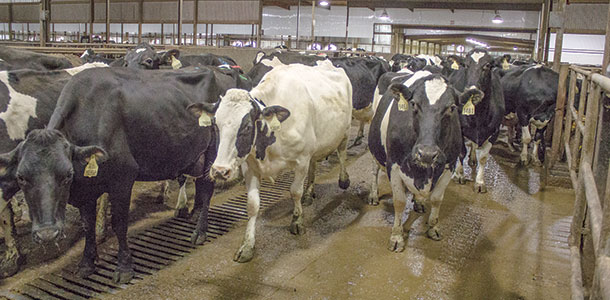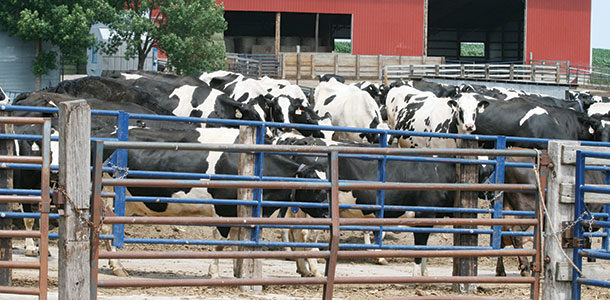The critical period prior to calving is often considered a time to reduce stress for the ladies in waiting, but at what point do factors like re-grouping and stocking density negatively impact fresh cow health and performance? University of Minnesota’s Dr. Ricardo Chebel shares the results of his research on these two close-up cow questions.
Does reducing stress associated with re-grouping result in a healthier, more productive lactation?
Chebel’s research reveals that when overcrowding is not a factor, it doesn’t really matter.
The researcher compared two close-up pen strategies. He looked at the conventional, stable method of bringing cows into the pen on a weekly basis and compared it to an all-in/all-out (AIAO) system where animals were moved in and out together in groups based on their days carrying calf.
“The idea of AIAO is that having a constant group without any re-grouping would reduce social disruption, reduce stress and keep the cows healthier through the transition period,” he says, acknowledging that the drawback to the concept is additional building costs – as much as 15 to 20 percent over traditional facilities.
Chebel put the theory to the test in order to see if stabilizing groups would result in reduced stress, thus preventing feed intake slumps that can lead to production losses and a host of fresh cow health problems.
He measured parameters of immune function such as immunoglobulin levels in colostrum as well as blood levels of non-esterified fatty acids (NEFA) and beta hydroxybutyrate (BHBA), indicators of fat mobilization.
Animals were monitored for changes in body condition and lameness scores, as well as milk production for the first 150 days post-calving, pregnancy rate at first A.I. and incidences of fresh cow health (retained placenta, metritis, displaced abomasum, etc.)
“When we looked at those parameters, they were not affected at all by the treatment,” Chebel says. “Further, we looked at the health of the cows, and we could not find any effects either.”
Even though there were some minor behavioral changes in the cows, no metabolic changes were observed. Cows kept in the same group tended to exhibit fewer disruptions in social interactions, but those that were re-grouped seemed to return to normal within two to five days – not long enough to cause negative biological impacts.
“Ultimately, when we look at production and reproduction, there were no positive effects of the stable grouping compared to the traditional,” Chebel points out.
When the fundamentals of prefresh cow management are being met, such as adequate bunk space and proper nutrition, Chebel believes new cows can be brought into the close-up pen once a week without negative impacts on health and production.
Some producers may have considered an AIAO strategy to reduce the time cows spend in close-ups, but Chebel warns against it.
“Trying to go for an AIAO strategy by reducing time cows spend in close-ups is a very bad idea. Cows need to be on the close-up diet for no less than 21 days,” he cautions. “If for some reason you want to use AIAO, just understand that the building expense will be higher and don’t do it at the detriment of the time cows spend in the close-up pen.”

How far can we push the limit on stocking density with close-up cows?
Keeping the close-up pen stocked at 80 percent has been considered the “gold standard,” but Chebel’s research suggests pens can be packed up to 100 percent so long as they are well-managed, and cows and heifers are separated from one another.
Previous research tied a decrease in milk production among heifers by 3.5 pounds per day for the first 80 days in milk to each 10 percent increase in stocking density above 80 percent. This information came from a retrospective evaluation of a dry cow feed additive where cows and heifers were grouped together.
Chebel’s extensive trial included 324 heifers and 404 cows, studied separately. At 80 percent stocking density, a pen with 48 headlocks and 44 stalls held 38 animals. At 100 percent, 48 animals were held in the same-size pen.
As in the re-grouping study, he noted changes in behavior and fewer negative social interactions among animals; however, there were no significant differences in immune function, health, milk production and reproduction between the two groups.
“We saw no benefits whatsoever,” Chebel says.
These results led him to believe that stocking the prefresh pen at only 80 percent could be an under-utilization of facilities, and well-managed close-up pens can operate at capacity.
“Some herds will not have a problem at 100 percent stocking density in their close-ups as long as they separate the heifers from the cows,” he adds.
Chebel warns producers, though, that 80 percent stocking density remains the rule for commingled cows and heifers.
“If heifers and cows are housed together, the heifers will really suffer,” he notes. “Don’t go above 80 percent in a mixed group because it presses the heifers too far.” PD
Photos by PD staff.

Peggy Coffeen
Editor
Progressive Dairyman







